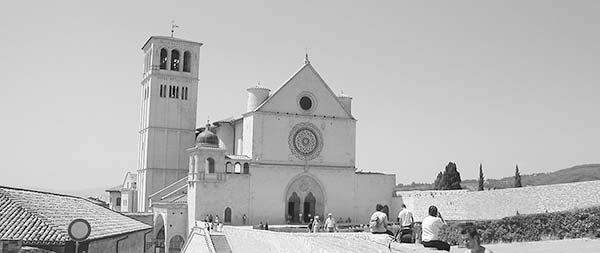
Map: Basilica of St. Francis—Lower Level
Map: Basilica of St. Francis—Upper Level
Map: Assisi Hotels & Restaurants
ABOVE THE BASILICA OF ST. FRANCIS
COUNTRYSIDE FARM-TO-TABLE DINNER
Assisi is famous for its hometown boy, St. Francis, who made very, very good. While Francis the saint is interesting, Francesco Bernardone the man is even more so, and mementos of his days in Assisi are everywhere—where he was baptized, a shirt he wore, a hill he prayed on, and a church where a vision changed his life.
Around the year 1200, this simple friar from Assisi countered the decadence of Church government and society in general with a powerful message of nonmaterialism and a “slow down and smell God’s roses” lifestyle. Like Jesus, Francis taught by example, living without worldly goods and aiming to love all creation. A huge monastic order grew out of his teachings, which were gradually embraced (some would say co-opted) by the Church. Christianity’s most popular saint and its purest example of simplicity is now glorified in beautiful churches, along with his female counterpart, St. Clare. In 1939, Italy made Francis one of its patron saints; in 2013, the newly elected pope took his name.
Francis’ message of love, simplicity, and sensitivity to the environment has a broad and timeless appeal. But every pilgrimage site inevitably gets commercialized, and Francis’ legacy is now Assisi’s basic industry. In summer, this Umbrian town bursts with flash-in-the-pan Francis fans and Franciscan knickknacks. Those able to see past the glow-in-the-dark rosaries and bobble-head friars can have a “travel on purpose” experience. Even a block or two off the congested main drag, you’ll find pockets of serenity that, it’s easy to imagine, must have made Francis feel at peace.
Assisi is worth a day and a night. Its walled old town has a half-day of sightseeing and another half-day of wonder. The essential sight is the Basilica of St. Francis. For a good visit, take my self-guided Assisi Walk, going from the top of town to the basilica at the bottom, and my Basilica of St. Francis Tour. With more time, wander the back streets and linger on the main square, Piazza del Comune.
Most visitors are day-trippers. While the town’s a zoo by day, it’s a delight at night. Assisi after dark is closer to a place Francis could call home. But for most visitors, two nights is more than you really need.
Crowned by a ruined castle, Assisi spills downhill to its famous Basilica of St. Francis. The town is beautifully preserved and rich in history. A 5.5-magnitude earthquake in 1997 did more damage to the tourist industry than to the town’s buildings. Fortunately, tourists—whether art lovers, pilgrims, or both—have returned, drawn by Assisi’s special allure.
The city stretches across a ridge that rises from a flat plain. The Basilica of St. Francis sits at the low end of town; Piazza Matteotti (bus stop and parking lot) is at the high end; and the main square, Piazza del Comune, lies in between. The main drag (called Via San Francesco for most of its course) runs from Piazza del Comune to the basilica. Capping the hill above the town is the ruined castle, called the Rocca Maggiore, and rising above that is Mount Subasio. The town is smaller than its fame might lead you to think: Walking uphill from the basilica to Piazza Matteotti takes 30 minutes, while the downhill journey takes about 15 minutes. Some Francis sights lie outside the city walls, in the flat area beneath the ridge (the modern part of town, called Santa Maria degli Angeli) and in the hills above.
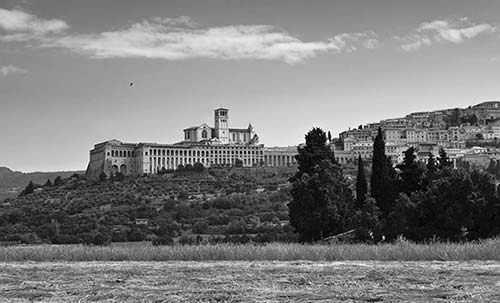
The TI is in the center of the old town on Piazza del Comune (daily 9:00-19:00, tel. 075-813-8680, www.visit-assisi.it). From April to October, there’s also a branch (with shorter hours) down in the valley, across the street from the big piazza in front of the Basilica of Santa Maria degli Angeli.
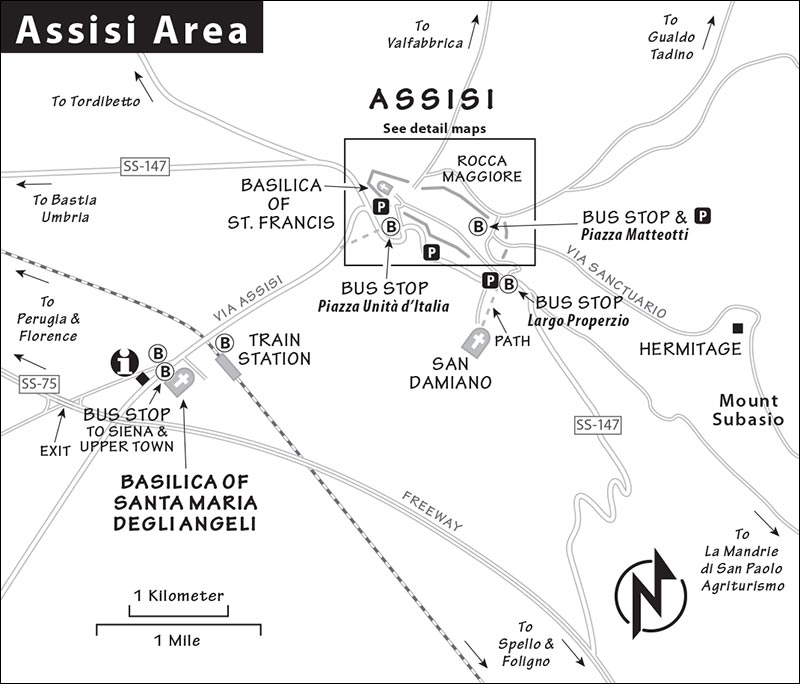
By Train: The train station is about two miles below Assisi, in Santa Maria degli Angeli. There is no official baggage storage, but the bar on the main floor will hold bags for a small charge (look for ristorante sign on the platform). There’s no baggage storage in the old town.
Gray-and-blue Busitalia city buses (line #C) connect the station with the hilltop old town, stopping just outside the wall at three convenient places. Buses usually leave twice hourly from the bus stop immediately to your left as you exit the station (daily 5:30-23:00, schedule posted at stop, 15-minute ride; buy tickets at the newsstand inside the train station for €1.30, or on board the bus for €2—exact change only, validate ticket at yellow box as you board). The bus may be awaiting the arrival of your train. If so, don’t dawdle or you may miss it.
Be sure you’re on a bus going toward the center (ask “Centro?”—it should be marked Matteotti/S. Francesco). On the way up into town, the bus makes three stops: Piazza Unità d’Italia (near Porta San Pietro, below the Basilica of St. Francis), Largo Properzio (just outside Porta Nuova), and finally up top at Piazza Matteotti. The middle stop, Largo Properzio, is best for hotels in the center—just walk through the gateway and take the straight, mostly level street (past the Basilica of St. Clare) about 10 minutes to the main square.
Returning from the old town to the train station, buses reverse the route, leaving Piazza Matteotti twice hourly, driving down through town to the train station (then proceeding one more stop to the Basilica of Santa Maria degli Angeli).
Taxis from the train station to the old town cost about €15, with extra charges for luggage, night service, additional people (four is customary)...and sometimes just for being a tourist. When departing the old town, you’ll find taxi stands at Piazza Giovanni Paolo II, the Basilica of St. Francis, the Basilica of St. Clare, and Piazza del Comune (or have your hotel call for you, tel. 075-813-100). Expect to pay a minimum of €10 for any ride.
By Bus: Buses from Siena generally arrive at the stop next to the Basilica of Santa Maria degli Angeli, near the train station (see earlier for directions from the station into town). Most other intercity buses arrive at the base of the old town.
By Car: Drivers coming in for the day can follow the signs to several handy parking lots (parcheggi). Piazza Matteotti’s wonderful underground parking garage is at the top of the town and comes with bits of ancient Rome in the walls. Another big lot, Parcheggio Giovanni Paolo II, is at the bottom end of town, 200 yards below the Basilica of St. Francis (next to the Piazza Unità d’Italia bus stop). At Parcheggio Porta Nuova, at the south end of town, an escalator delivers you to Porta Nuova near St. Clare’s. The lots vary in price (about €1.50/hour, most €20/day). For day-trippers, the best plan is to park at Piazza Matteotti, follow my self-guided town walk, tour the Basilica of St. Francis, and then either catch a bus back to Piazza Matteotti or simply wander back up through town to your car.
Best Shopping: Tacky knickknacks line the streets leading to the Basilica of St. Francis. For better shops (with local handicrafts), head to Via San Rufino and Corso Mazzini (both just off Piazza del Comune; some shops described on here). A Saturday-morning market fills Via Borgo San Pietro (along the bottom edge of town).
Festivals: Assisi hosts several annual festivals commemorating St. Francis and life in the Middle Ages. The springtime medieval Festa di Calendimaggio features costume parades, concerts, and competitions among Assisi’s rival neighborhoods (www.calendimaggiodiassisi.it). The Settimana Francescana commemorates the beginning of the end of Francis’ life, when he made his way for the last time to the Porziuncola Chapel (Sept 28). This week-long celebration culminates on October 4 in the Festa di San Francesco, which marks his death with religious processions, special church services, and an arts, crafts, and folklore fair.
Laundry: If they’re not too busy, 3 Elle Blu’ Lavanderia can do same-day laundry for you at a reasonable price (Mon-Fri 9:00-18:00, Sat until 13:00, closed Sun, Via Borgo Aretino 6a, tel. 075-816-084).
Travel Agencies: You can purchase train, bus, and plane tickets at Agenzia Viaggi Stoppini, centrally located between Piazza del Comune and the Basilica of St. Clare. Manager Fabrizio is patient with tourists’ needs (Mon-Fri 9:00-12:30 & 15:30-19:00, Sat 9:00-12:30, closed Sun, also offers day trips to nearby towns, Corso Mazzini 31, tel. 075-812-597, www.viaggistoppiniassisi.it).

Local Guides: Giuseppe Karabotis is a good licensed guide (€130/3 hours, €260/6 hours, mobile 328-867-0567, iokarabot@libero.it). Daniela Moretti is a hardworking young guide from Perugia who knows Assisi and all of Umbria (€120/half-day, €240/day, mobile 335-829-9984, www.danyguide.com [URL inactive], danyguide@hotmail.com). If they’re busy, they can recommend other guides.
Most visitors need only their feet to get everywhere in Assisi, except to the lower town—with the train station and Basilica of Santa Maria degli Angeli—which can be reached on Busitalia line #C (see directions earlier, under “Arrival in Assisi”).
Within the old town, minibuses #A and #B run every 20-40 minutes, linking the lower end (near the Basilica of St. Francis) with the middle (Piazza del Comune) and the top (Piazza Matteotti). While it’s only a 15-minute stroll from the upper end to the lower, the climb back up can have you looking for a lift. Hop on a bus marked Piazza Matteotti if you’re exhausted after your Basilica of St. Francis visit and need a sweat-free five-minute return to the top of the old town. Before boarding, confirm the destination (catch the bus below the basilica, just outside the Porta San Francesco).
You can buy a bus ticket (good on any city bus) at a newsstand or tobacco shop for €1.30, or get a ticket from the driver for €2 (exact change only). After you’ve stamped your ticket on board, it’s valid for 90 minutes.
There’s much more to Assisi than just St. Francis and what the blitz tour groups see. This self-guided walk, worth ▲▲, covers the town from top to bottom, starting near Piazza Matteotti. To reach the piazza, ride the bus from the train station (or from Piazza Giovanni Paolo II) to the last stop; drive up (and park in the underground lot); or hike 10 minutes uphill from Piazza del Comune.
 Download my free Assisi Town Walk audio tour.
Download my free Assisi Town Walk audio tour.
• Start 50 yards beyond Piazza Matteotti (down the small lane between two stone houses, away from city center—see map).
A lane named Via Anfiteatro Romano skirts the cozy neighborhood built around the site of a long-gone Roman amphitheater—a reminder that Assisi was once an important Roman town. Circle to the right along the curved lane that marks the amphitheater’s footprint. Imagine how colorful the town laundry basin (on the right) must have been in previous generations, when the women of Assisi gathered here to do their wash. Just beyond, above another small rectangular basin, are the coats of arms of Assisi’s leading families. A few steps farther, leave the amphitheater, hiking up the stairs on the right to the top of the hill, for an overhead view of the ancient oval. The Roman stones have long been absorbed into the medieval architecture. It was Roman tradition to locate the amphitheater outside of town, which this used to be. While the amphitheater dates from the first century AD, the buildings filling it today were built in the 13th and 14th centuries. Notice the town’s carefully maintained complexion: When redoing a roof, locals will mix old and new tiles.
• Continue on, enjoying the grand view of the fortress in the distance. Take the gravel lane that branches off to the right, leading down to a city gate (on the right). Step through the gate for an...
Outside of Assisi’s Porta Perlici stretches a commanding view. Umbria, called the “green heart of Italy,” is the country’s geographical center and only landlocked region. Enjoy the various shades of green: silver green on the valley floor (olives), emerald green (grapevines), and deep green on the hillsides (evergreen oak trees). The valleys are dotted by small family farms, many of which rent rooms as agriturismi. Also notice Rocca Maggiore (“big fortress”), which provided townsfolk a refuge in times of attack. In the opposite direction, Rocca Minore (“little fortress”)—which you saw a moment ago—gives the town’s young lovers a little privacy. A quarry under the Rocca Maggiore was a handy source for Assisi’s characteristic pink limestone.
• Go back through the gate and follow Via Porta Perlici—it’s immediately on your right—downhill into town (toward Hotel la Rocca). Enjoy the higgledy-piggledy architecture (this neighborhood has some of the most photogenic back lanes in town). Fifty yards down, to the left of the arched gate, find the wall containing an aqueduct that dates from Roman times. It still brings water from a mountain spring into the city (push the brass tap for a taste). After another 50 yards, turn left through a medieval town gate (with Hotel la Rocca on your right). Just after the hotel, you’ll pass a second gate dating from Roman times. Follow Via Porta Perlici a few atmospheric blocks downhill until you hit a fine square facing a big church.
Trick question: Who’s Assisi’s patron saint? While Francis is one of Italy’s patron saints, Rufino (the town’s first bishop, martyred and buried here in the third century) is Assisi’s. This cathedral (seat of the local bishop)—worth ▲▲—is 11th-century Romanesque with a Neoclassical interior, and dedicated to Rufino. Although it has what is considered to be one of the best and purest Romanesque facades in all of Umbria, the big triangular top (just a decorative wall) was added in Gothic times.
Cost and Hours: Cathedral—free, daily 7:00-19:00, Nov-mid-March closed Mon-Fri 12:30-14:30, tel. 075-812-283; museum—€3.50, Thu-Tue 10:00-13:00 & 15:00-18:00, closed Wed, shorter hours off-season and Sun, www.assisimuseodiocesano.it.

Visiting the Church: Before going in, study the facade—a jungle of beasts emphasizing how the church was a refuge and sanctuary in a scary world. Notice the lions at the base of the facade, flanking each door. One is eating a Christian martyr, reminding worshippers of the courage of early Christians. Here, as in other medieval Assisi churches, worshippers absorbed pre-Christian themes and symbols into their world.
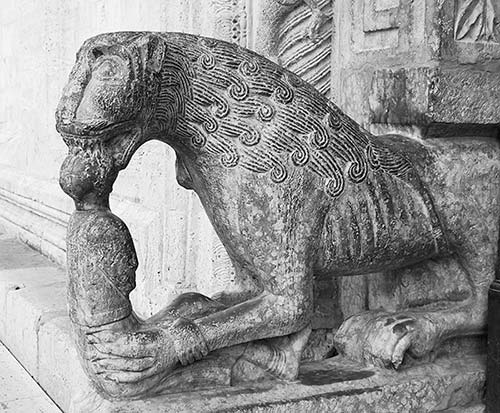
Enter the church. While the front of the church is an unremarkable mix of 17th- and 18th-century Baroque and Neoclassical, the rear (near where you enter) has several points of interest. Notice the two fine statues at the bases of the first pillars: St. Francis and St. Clare (by Giovanni Dupré, 1888).
In the church’s back-right corner is an old baptismal font (surrounded by a semicircular black iron grate). In about 1181, a baby boy was baptized in this font. His parents were upwardly mobile Francophiles who called him Francesco (“Frenchy”). In 1194, a nobleman baptized his daughter Clare here. Eighteen years later, their paths crossed in this same church, when Clare attended a class and became mesmerized by the teacher—Francis. Traditionally, the children of Assisi are still baptized here.
In the nave, the striking glass panels in the floor reveal foundations preserved from the ninth-century church that once stood here. You’re walking on history. After the 1997 earthquake, structural inspectors checked the church from ceiling to floor. When they looked under the paving stones, they discovered graves (until Napoleon decreed otherwise, it was common practice to bury people in churches). Underneath that level, they found Roman foundations and some animal bones (suggesting the possibility of animal sacrifice). There might have been a Roman temple here; churches were often built upon temple ruins. Stand at the back of the church facing the altar, and look left to the Roman cistern that collected rainwater (just beyond the great stone archway, next to where you entered). Take the three steps down (to trigger the light) and marvel at the fine stonework and Roman engineering. In the Middle Ages, this was the town’s emergency water source when under attack.
Diocesan Museum: Underneath the church, incorporated into the Roman ruins and columns, are the foundations of an earlier Church of San Rufino, now the crypt and a fine little museum. When it’s open, you can go below to see the saint’s sarcophagus (third century) and the cathedral’s art from centuries past (down the stairs, near the baptismal font, well-described in English).
• Leaving the church, walk to the end of the square and take a sharp left (at the pizza-by-the-slice joint, on Via Dono Doni). After 20 yards, take a right and go all the way down the stairway to see some...
At the bottom of the stairs, notice the pink limestone pavement, part of the surviving medieval town. The arches built over doorways indicate that the buildings date from the 12th through the 14th century, when Assisi was booming. Italian cities such as Assisi—thriving on the north-south trade between northern Europe and Rome—were in the process of inventing free-market capitalism, dabbling in democratic self-rule, and creating the modern urban lifestyle. The vaults you see that turn lanes into tunnels are reminders of medieval urban expansion—creating more living space (mostly 15th century). While the population grew, people wanted to live within the town’s protective walls. Medieval Assisi had several times the population density of modern Assisi.
Notice the blooming balconies; Assisi holds a flower competition each June.
• From the bottom of the stairs, head to the left and continue downhill. When you arrive at a street, turn left, going slightly uphill for a long block, then take the low road (right) at the Y, and head down Via Sermei. Continue down to the big church. Walk right, under the three massive buttresses, to Piazza Santa Chiara and the front of the church.
Dedicated to the founder of the Order of the Poor Clares, this Umbrian Gothic church—worth ▲▲—is simple, in keeping with the nuns’ dedication to a life of contemplation. In Clare’s lifetime, the order was located in the humble Church of San Damiano, in the valley below, but after Clare’s death, they needed a bigger and more glorious building. The church was built in 1265, and the huge buttresses were added in the next century.
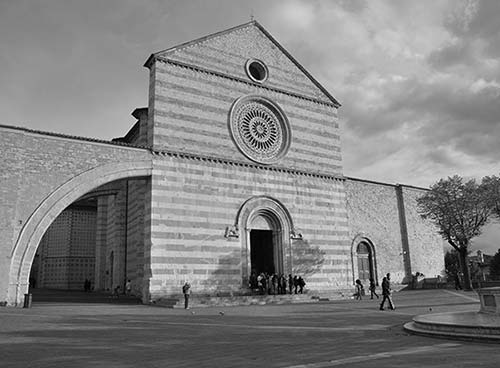
Cost and Hours: Free, daily 6:30-12:00 & 14:00-19:00, until 18:00 in winter, crypt opens Mon-Fri at 9:00, tel. 075-812-282.
Visiting the Basilica: The interior’s fine frescoes were whitewashed in Baroque times. The battered remains of one on the left show how the fresco surface was hacked up so whitewash would stick. Imagine all the pristine frescoes hiding behind the whitewash (here and all over Europe).
On the right is the door to the Chapel of the Crucifix of San Damiano, with the simple wooden crucifix that changed Francis’ life. In 1206, an emaciated, soul-searching, stark-raving Francis knelt before this crucifix of a living Christ (then located in the Church of San Damiano) and asked for guidance. According to legend, the crucifix spoke: “Go and rebuild my Church, which you can see has fallen into ruin.” Francis followed the call.
Stairs lead from the nave down to the tomb of St. Clare. Her tomb—discovered in about 1850—is at the far right end of the richly ornamented neo-Gothic crypt (the image is fiberglass; her actual bones lie underneath). As you circulate with the crowd of pilgrims, notice the paintings on the walls depicting spiritual lessons from Clare’s life and death. At the opposite end of the crypt (back between the stairs, in a large glassed-in area, well-described on the wall) are important relics: the saint’s robes, hair (in a silver box), and an enormous tunic she made—along with relics of St. Francis (including a bloodstained stocking he wore after receiving the stigmata). The attached cloistered community of the Poor Clares has flourished for 700 years.
• Leave the church and belly up to the viewpoint at the edge of the square for...
Another Umbrian View: On the left is the convent of St. Clare (global headquarters of all the Poor Clares). Below you lies the olive grove of the Poor Clares, which has been there since the 13th century. In the distance is a grand Umbrian view. Assisi overlooks the richest and biggest valley in otherwise hilly and mountainous Umbria. Across the valley to the far right (and over the Tiber River), the rival town Perugia, where Francis was imprisoned, sits on its own hill.
The lower town, called Santa Maria degli Angeli, grew up with the coming of the railway in the 19th century. In the haze, the church with the grayish-blue dome is the Basilica of Santa Maria degli Angeli (described later), the cradle of the Franciscan order. A popular pilgrimage site today, it marks the place where St. Francis lived, worked, and died.
By the way, many Spanish-speaking Franciscans settled in California. Three of their missions grew into major cities: Los Angeles (named after this church), San Francisco (named after St. Francis), and Santa Clara (named after St. Clare).
• From the church square, step out into Via Santa Chiara.
Look left and right to find three old town gates, which illustrate how the city has grown (in concentric circles) since antiquity. First, look to the left, uphill on Via Santa Chiara, the high road. This first arch marks the site of the original Roman wall. In Roman days, this was the extent of Assisi. Now look right, beyond the church. This old gate over the road dates from 1265, as the town expanded during the boom years and the city wall was pushed outward. Farther on, you can just make out the crenellations of the third gate: the Porta Nuova. Built in 1316, this “New Gate” marks the final expansion of Assisi, before its centuries of slow decline.
Walk uphill along Via Santa Chiara (which becomes Corso Mazzini) to the city’s main square. As you pass under the arch you enter what was Roman Assisi—the city that Francis knew. The street is lined with interesting shops selling traditional embroidery, religious souvenirs, and gifty edibles. The shops on Corso Mazzini, on the stretch between the gate and Piazza del Comune, show off many local crafts. As you browse, watch for the following shops:
Galleria d’Arte Perna (on the left, #20b) sells the medieval fantasy townscapes of Paolo Grimaldi, a local painter who runs this shop with his brother, Alessandro.
A helpful travel agency is across the street and a few steps up (at #31, Agenzia Viaggi Stoppini; see “Helpful Hints,” earlier).
Next, the aptly named Assisi Olive Wood (on the left at #14E) sells olive-wood carvings, as does d’Olivo, across the street at #23. It’s said that St. Francis made the first Nativity scene to help humanize and, therefore, teach the Christmas message. That’s why you’ll see so many crèches in Assisi. (Even today, nearby villages are enthusiastic about their “living” manger scenes, and Italians everywhere enjoy setting up elaborate crèches in churches for Christmas.)
At #14A (also on the left) is a bakery, Bar Sensi, selling the traditional raisin-and-apple strudel called rocciata (roh-CHAH-tah, big enough to share).
Farther along on the left (on the corner at #2A) is Antichita il Duomo, selling religious art, manger scenes, Christmas ornaments, and Crucifixion figurines. Across the street at #5A is Galleria del Corso, selling finely embroidered linens and baby clothes.
And on the square (at #34, on the right), the recommended La Bottega dei Sapori is worth a visit for edible and drinkable souvenirs.
You’ve walked up what was, in ancient times, the main drag into town. Ahead of you, the six fluted Corinthian columns of the Temple of Minerva marked the forum (today’s Piazza del Comune). Sit at the fountain on the piazza for a few minutes of people-watching—don’t you just love Italy? Within a few hundred yards of this square, on either side, were the medieval walls. Imagine the commotion of 5,000 people confined within these walls. No wonder St. Francis needed an escape for some peace and quiet.
Today, while the municipality of Assisi has a population of 25,000, only 3,500 people live in the old town: Many who left damaged homes after the 1997 earthquake decided to stay in the modern city below. This is one reason for the old town’s plethora of tourist shops (and few services for residents like supermarkets or hardware stores).
• Now, head over to the temple on the square.
Assisi has always been a spiritual center. The Romans went to great lengths to make this first-century BC Temple of Minerva a centerpiece of their city. Notice the columns that cut into the stairway. It was a tight fit here on the hilltop. In ancient times, the stairs went down—about twice as far as they do now—to the main drag, which has gradually been filled in over time. The Church of Santa Maria sopra (“over”) Minerva was added in the 9th century. The bell tower is from the 13th century.
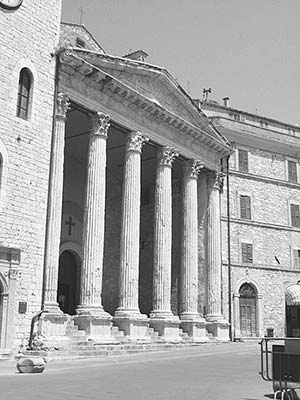
Pop inside the temple/church (free, daily 7:15-19:30, in winter closes at sunset and midday). Today’s interior is 17th-century Baroque. Walk to the front. Flanking the altar to the back are the original Roman temple floor stones. You can even see the drains for the bloody sacrifices that took place here. Behind the statues of Peter and Paul, the original Roman embankment peeks through.
As you exit the church, look to the right, next to the door of the bell tower. The shapes set into the wall are the medieval city standards for the market that used to take place here. The large shapes are building materials, bricks, and roof tiles. The metal bars were the official measuring sticks for goods sold by length, a measurement that could change from city to city.
• Across the square next to #11, step into the 16th-century frescoed vaults of the...
Loggia of the Palazzo del Comune: Notice the Italian flair for fine design. Even this little loggia features decorative art (in the Grotesque style—named for the fanciful paintings of bizarre creatures found on unfinished lower-level walls at Nero’s Golden House in Rome). This scene was indisputably painted after 1492. How do they know? Because it features turkeys—first seen in Europe after Columbus returned from the Americas with his ship full of exotic souvenirs. The turkeys painted here may have been that bird’s European debut.
• From the main square, hike left past the temple up the high road, Via San Paolo. After 150 yards (across from #24), a sign on the left directs you down a stepped lane to the...
Surrounded by cypress, fig, and walnut trees, Santo Stefano—which used to be outside the town walls in the days of St. Francis—is a delightful bit of offbeat Assisi (free, daily 8:30-20:00, shorter hours off-season). Legend has it that Santo Stefano’s bells miraculously rang on October 3, 1226, the day St. Francis died. Step inside. This is the typical rural Italian Romanesque church—no architect, just built by simple stonemasons who put together the most basic design. Hundreds of years later, it still stands.
• The lane zigzags down to Via San Francesco. When you reach the narrow lane, go left (downhill). Then, emerging at the wider street, turn right and walk under the arch toward the Basilica of St. Francis. To trace the rest of our route, see the “Assisi” map on here.
This main drag leads from the town to the basilica holding the body of St. Francis. Francis was a big deal even in his own day. He was made a saint in 1228—the same year that the basilica’s foundations were laid—and his body was moved here by 1230. Assisi was a big-time pilgrimage center, and this street was its booming hub. The arch marks the end of what was Assisi in St. Francis’ day. Notice the fine medieval balcony immediately past the arch (on the left).
About 30 yards farther down (on the left), find the fountain where medieval pilgrims might have cooled themselves. The hospice next door was built in 1237 to house pilgrims. Notice the three surviving faces of its fresco: Jesus, Francis, and Clare.
Farther down on the left, across from #12A, is the Oratorio dei Pellegrini, dating from the 1450s. A brotherhood ran a hostel here for travelers passing through to pay homage to St. Francis. The chapel offers a richly frescoed 14th-century space designed to inspire pilgrims—perfect for any traveler to pause and contemplate the saint’s message (Mon-Fri 9:00-12:00 & 16:00-18:00, Sat afternoon only, closed Sun).
From here, the road continues a few more short blocks downhill to the Basilica of St. Francis. Just before the basilica is a three-floor museum about Capuchin missionaries’ work in the Amazon region since 1909 (Museo Missionario Indios, on the left at #19, closed Mon). Depending on your feelings about missionaries in the developing world, this may be of interest—with exhibits on ethnography, flora and fauna, and Franciscan theology.
• Continuing on, you’ll reach Assisi’s main sight, the Basilica of St. Francis. For the start of my self-guided tour, walk downhill to the basilica’s lower courtyard.
The Basilica of St. Francis (Basilica di San Francesco), worth ▲▲▲, is one of the artistic and religious highlights of Europe. It stands where, in 1226, St. Francis was buried (with the outcasts he had stood by) outside of his town on the “Hill of the Damned”—now called the “Hill of Paradise.” The basilica is frescoed from top to bottom with scenes by the leading artists of the day: Cimabue, Giotto, Simone Martini, and Pietro Lorenzetti. A 13th-century historian wrote, “No more exquisite monument to the Lord has been built.”
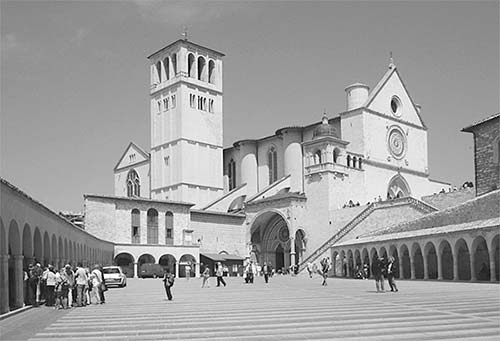
From a distance, you see the huge arcades “supporting” the basilica. These were 15th-century quarters for the monks. The arcades that line the square and lead to the church housed medieval pilgrims.
Cost and Hours: The complex is free to enter, with different hours for various parts. The lower basilica and tomb are open to tourists daily 6:00-17:30, Nov-March until 16:30—but in practice, the space remains open for worship (and discreet sightseers) more than an hour later. Within the lower basilica, the reliquary chapel opens at 9:00 but is often closed Sat-Sun (and occasionally at other times for religious services). The upper basilica is open daily 8:30-18:50, Nov-March until 18:00. And the skippable treasury/museum is open Mon-Tue and Thu-Sat 9:30-18:00, Sun 11:00-17:00, closed Wed, shorter hours off-season, closed Jan-Feb.
Dress Code: Modest dress is required to enter the church—no above-the-knee skirts or shorts and no sleeveless tops for men, women, or children.
Information: Tel. 075-819-0170, www.sanfrancescoassisi.org. Call or check the website to find out about upcoming events at the basilica. A handy information office is in the arcade of the lower courtyard—on the right as you face the church (Mon-Sat 9:00-18:00, closed Sun, shorter hours off-season).
Tours: Videoguides loaded with a one-hour tour are available at the information office under the arcade in the courtyard of the lower basilica (€6, €10/2 people).
 Download my free Basilica of St. Francis audio tour.
Download my free Basilica of St. Francis audio tour.
Bookstore: The church bookshop is in the inner courtyard behind the upper and lower basilica. It sells an excellent guidebook, The Basilica of Saint Francis: A Spiritual Pilgrimage (€3, by Goulet, McInally, and Wood); I used this book, and a tour with Brother Michael, as sources for this self-guided tour.
Church Services: To worship in the basilica, consider joining the Franciscan brothers for Mass in Italiano (Mon-Sat at 7:15, 11:00, and 18:00—or 17:00 off-season; Sun at 7:30, 9:00, 10:30, 12:00, 17:00, and 18:30), or experience a Mass sung by the basilica choir many Sundays at 10:30. On Sundays in summer (Easter-Oct), there’s an English Mass in the upper basilica at 9:00. Additional English and sung Masses don’t follow a set schedule. Call the basilica to find out when English-speaking pilgrimage groups or choirs have reserved Masses, and attend with them (tel. 075-819-0170).
The Basilica of St. Francis, a theological work of genius, can be difficult for the 21st-century tourist/pilgrim to appreciate.
Since the basilica is the reason that most people visit Assisi, and the message of St. Francis has even the least devout sightseers blessing the town Vespas, I’ve designed this self-guided tour with an emphasis on the place’s theology (rather than art history).
A disclaimer before we start: Just as Francis used many biblical legends to help teach the Christian message, legends from the life of Francis were told in later ages to teach the same message. Are they true? In general, probably not. Are they in keeping with Francis’ message? Yes. Do I share legends here as if they are historic? Sure.
The church has three parts: the upper basilica, the lower basilica, and the saint’s tomb (below the lower basilica). We’ll tour the complex from the bottom up. To get oriented, head down the ramp from the grassy lawn and stand in the big plaza that stretches in front of the lower entrance. While empty today, centuries ago this main piazza was cluttered with pilgrim services and the medieval equivalent of souvenir shops. As you face the church, the information office is under the arcade to your right, and the WCs are just behind that. (Go before you enter, as there aren’t any WCs inside the basilica.)
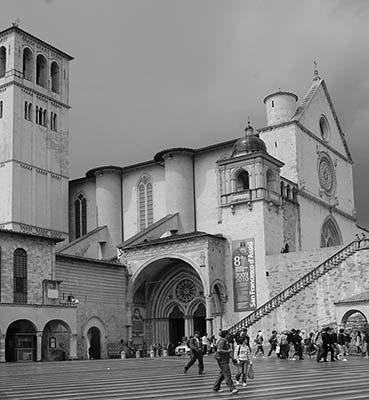
 SELF-GUIDED TOUR
SELF-GUIDED TOUREnter through the grand doorway of the lower basilica. Just inside, decorating the top of the first arch, look up and see St. Francis, who greets you with a Latin inscription. Sounding a bit like John Wayne, he says the equivalent of, “Slow down and be joyful, pilgrim. You’ve reached the Hill of Paradise. And, if you’re observant and thoughtful, this church will knock your spiritual socks off.”
• Start with the tomb. To get there, turn left into the nave. Midway down, follow the signs and go right, to the tomb downstairs.
The saint’s remains are above the altar in the stone box with the iron ties. In medieval times, pilgrims came to Assisi because St. Francis was buried here. Holy relics were the “ruby slippers” of medieval Europe. Relics gave you power—they answered your prayers and won your wars—and ultimately helped you get back to your eternal Kansas. Assisi made no bones about promoting the saint’s relics, but hid his tomb for obvious reasons of security. His body was buried secretly while the basilica was under construction, and over the next 600 years, the exact location was forgotten. When the tomb was to be opened to the public in 1818, it took more than a month to find his actual remains.
Francis’ four closest friends and first followers are memorialized in the corners of the room. Opposite the altar, up four steps between the entrance and exit, notice the small copper box behind the metal grille. This contains the remains of Francis’ rich Roman patron, Jacopa dei Settesoli. She traveled to see him on his deathbed but was turned away because she was female. Francis waived the rule and welcomed “Brother Jacopa” to his side. These five tombs—in the Franciscan spirit of being with your friends—were added in the 19th century.
The candles you see are the only real candles in the church (others are electric). Pilgrims pay a coin, pick up a candle, and place it in the small box on the side. The friars will light it later.
• Climb back up to the lower nave.
Appropriately Franciscan—subdued and Romanesque—this nave is frescoed with parallel scenes from the lives of Christ (right) and Francis (left), connected by a ceiling of stars. The Passion of Christ and the Compassion of Francis lead to the altar built over Francis’ tomb. After the church was built and decorated, side chapels were erected to provide mausoleums for the rich families that patronized the work of the order. Unfortunately, in the process, huge arches were cut out of some frescoed scenes, but others survive.
In the fresco directly above the entry to the tomb, Christ is being taken down from the cross (just the bottom half of his body can be seen, on the left), and it looks like the story is over. Defeat. But in the opposite fresco (above the tomb’s exit), we see Francis preaching to the birds, reminding the faithful that the message of the Gospel survives.
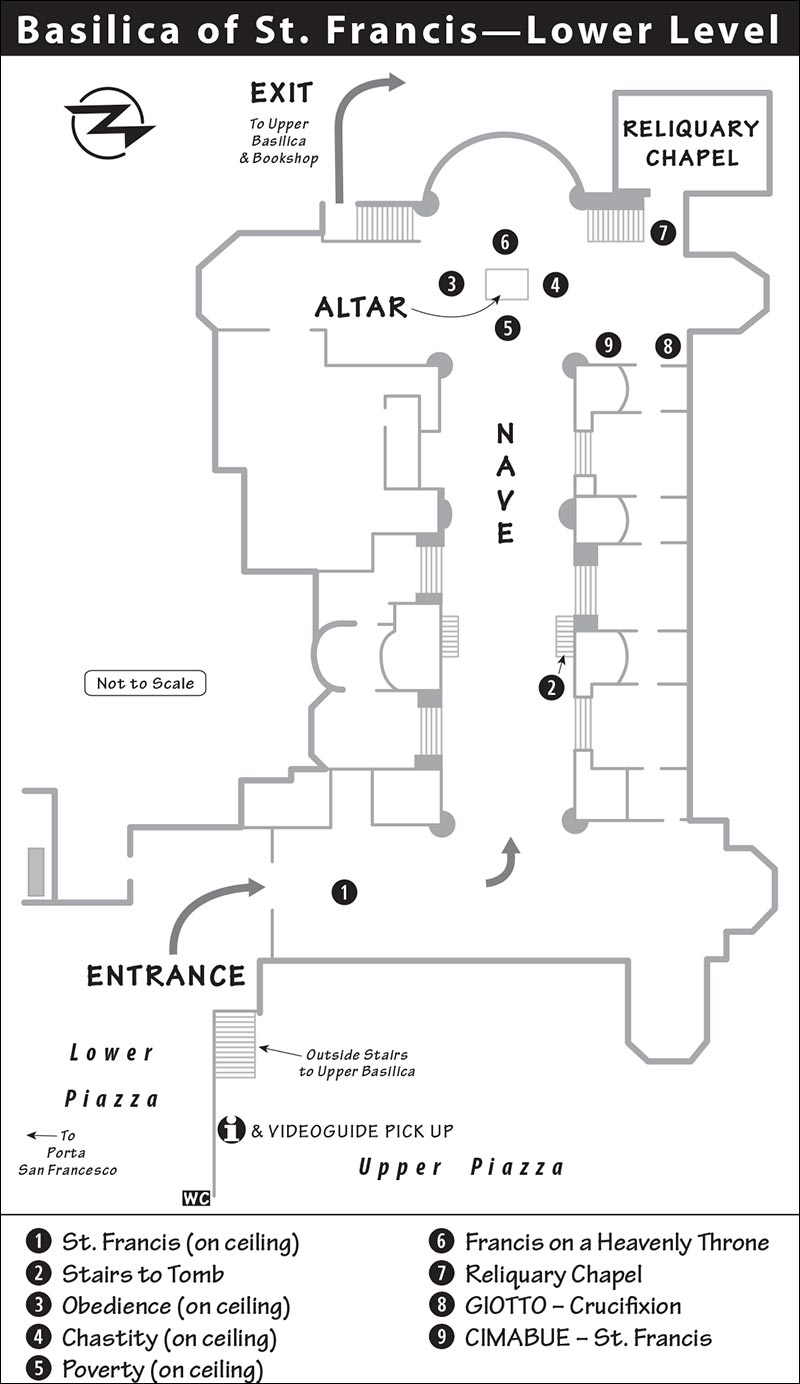
These stories directed the attention of the medieval pilgrim to the altar, where he could meet God through the sacraments. The church was thought of as a community of believers sailing toward God. The prayers coming out of the nave (navis, or ship) fill the triangular sections of the ceiling—called vele, or sails—with spiritual wind. With a priest for a navigator and the altar for a helm, faith propels the ship.
Walk around the altar, stand behind it (toes to the bottom step, facing the entrance), and look up. The three scenes above you represent the creed of the Franciscans: Directly above the tomb of St. Francis, to the right, Obedience (Francis appears twice, wearing a rope harness and kneeling in front of Lady Obedience); to the left, Chastity (in her tower of purity held up by two angels); and straight ahead, Poverty. Here Jesus blesses the marriage as Francis slips a ring on Lady Poverty. In the foreground, two “self-sufficient” yet pint-size merchants (the new rich of a thriving northern Italy) are throwing sticks and stones at the bride. But Poverty, in her patched wedding dress, is fertile and strong, and even bare brambles blossom into a rosebush crown.
St. Francis called money the “devil’s dung.” The jeweled belt of a rich person was all about material wealth. A bag of coins hung from it, as did a weapon to protect that wealth. The simple rope Franciscan monks use to tie their tunics has three knots that symbolize—and serve as constant reminders of—their vows of obedience, chastity, and poverty.
Now turn around and put your heels to the altar and—bending back like a drum major—look up for a peek at the reward for a life of obedience, chastity, and poverty: Francis on a heavenly throne in a rich, golden robe. He traded a life of earthly simplicity for glory in heaven.
• Turn to the right and march to the corner, where steps lead down into the...
This chapel is filled with fascinating relics (which a €0.50 flier explains in detailed English; often closed Sat-Sun). Step in and circle the room clockwise. You’ll see the silver chalice and plate that Francis used for the bread and wine of the Eucharist (in a small, dark, windowed case set into the wall, marked Calice e Patena). Francis believed that his personal possessions should be simple, but the items used for worship should be made of the finest materials. Next, the Veli di Lino is a cloth Jacopa wiped her friend’s brow with on his deathbed. In the corner display case is a small section of the itchy haircloth (cilizio)—not sheep’s wool, but cloth made from scratchy horse or goat hair—worn by Francis as penance (the cloth he chose was the opposite of the fine fabric his father sold). In the next corner are the tunic and slippers that Francis donned during his last days. Next, find a prayer (in a fancy silver stand) that St. Francis wrote for Brother Leo and signed with a T-shaped character—his tau cross. The last letter in the Hebrew alphabet, tav (“tau” in Greek) is symbolic of faithfulness to the end, and Francis adopted it for his signature. Next is a papal document (1223) legitimizing the Franciscan order and assuring his followers that they were not risking a (deadly) heresy charge. Finally, just past the altar, see the tunic that was lovingly patched and stitched by followers of the five-foot, four-inch-tall St. Francis.
Before leaving the chapel, notice the modern paintings done recently by local artists. Over the entrance, Francis is shown being born in a stable like Jesus (by Capitini). Scenes from the life of Clare and Padre Pio (a Capuchin priest, very popular in Italy, who was sainted in 2002) were painted by Stefanelli and Antonio.
• Return up the stairs, stepping into the...
The decoration of this church brought together the greatest Sienese (Lorenzetti and Simone Martini) and Florentine (Cimabue and Giotto) artists of the day.
Look around at the painted scenes. In 1300, this was radical art—believable homespun scenes, landscapes, trees, real people. Directly opposite the reliquary chapel, study Giotto’s painting of the Crucifixion, with the eight sparrow-like angels. For the first time, holy people are expressing emotion: One angel turns her head sadly at the sight of Jesus, and another scratches her hands down her cheeks, drawing blood. Mary (lower left), previously in control, has fainted in despair. The Franciscans, with their goal of bringing God to the people, found a natural partner in Europe’s first naturalist (and therefore modern) painter, Giotto.
To grasp Giotto’s artistic leap, compare his work with the painting to the right, by Cimabue. It’s Gothic, without the 3-D architecture, natural backdrop, and slice-of-life reality of Giotto’s work. Cimabue’s St. Francis (far right) shows the saint with the stigmata—Christ’s marks of the Crucifixion. Contemporaries described Francis as being short, with a graceful build, dark hair, and sparse beard. (This is considered the most accurate portrait of Francis—done according to the description of one who knew him.) The sunroof haircut (tonsure) was standard for monks of the day. According to legend, the brown robe and rope belt were inventions of necessity. When Francis stripped naked and ran away from Assisi, he grabbed the first clothes he could, a rough wool peasant’s tunic and a piece of rope, which became the uniform of the Franciscan order.
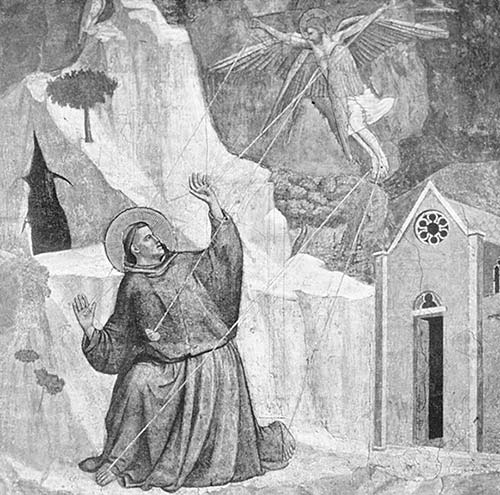
To the left, at eye level under the sparrow-like angels, are paintings of saints and their exquisite halos (by Simone Martini or his school). To the right of the door at the same level, see five of Francis’ closest followers—clearly just simple folk.
Francis’ friend, “Sister Bodily Death,” was really not all that terrible. In fact, Francis would like to introduce you to her now (above and to the right of the door leading into the reliquary chapel). Go ahead, block the light from the door with this book and meet her. Before his death, Francis added a line to The Canticle of the Sun: “Praise for our sister, Bodily Death, from whose embrace none can escape.”
• Now, cross the transept to the other side of the altar (enjoying some of the oldest surviving bits of the inlaid local-limestone flooring—c. 13th century) and find the staircase going up. Immediately above the stairs is Lorenzetti’s Francis Receiving the Stigmata. (Francis is considered the first person ever to earn the marks of the cross through his great faith and love of the Church.) Make your way up the stairs to the...
The courtyard overlooks the 15th-century cloister, the heart of this monastic complex. Pope Sixtus IV (of Sistine Chapel fame) had it built as a secure retreat for himself. Balanced and peaceful by design, the courtyard also functioned as a cistern to collect rainwater, supplying enough for 200 monks (today, there are about 40). The Franciscan order emphasizes teaching. This place functioned as a kind of theological center of higher learning, which rotated monks in for a six-month stint, then sent them back home more prepared and better inspired to preach effectively. That explains the complex narrative of the frescoes wallpapering the walls and halls here.
The treasury (Museo del Tesoro) to the left of the bookstore features ornately decorated chalices, reliquaries, vestments, and altarpieces.
• From the courtyard, climb the stairs (next to the bookshop) to the...
Built later than its counterpart below, the brighter upper basilica is considered the first Gothic church in Italy (started in 1228). You’ve followed the intended pilgrims’ route, entering the lower church and finishing here. Notice how the pulpit (embedded in the corner pillar) can be seen and heard from every spot in the packed church. The spirit of the order was to fill the church and preach. See also the design in the round window in the west end (high above the entry). The tiny centerpiece reads “IHS” (the first three letters of Jesus’ name in Greek). And, as you can see, this trippy kaleidoscope seems to declare that all light radiates from Jesus.
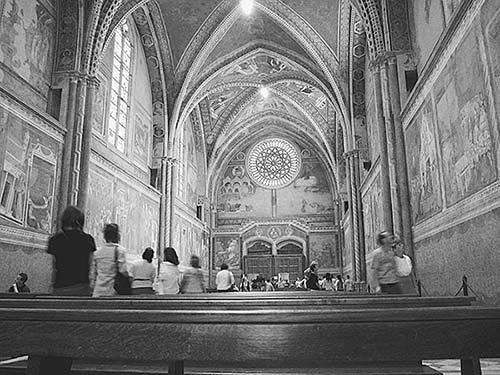
The windows here are treasures from the 13th and 14th centuries. Those behind the altar are among the oldest and most precious in Italy. Imagine illiterate medieval peasants entranced by these windows, so full of meaning that they were nicknamed “Bibles of the Poor.”
But for art lovers, the basilica’s draw is that Giotto and his assistants practically wallpapered it circa 1297-1300. Or perhaps the job was subcontracted to other artists—scholars debate it (for more on Giotto, see here). Whatever the case, the anatomy, architectural depth, and drama of these frescoes helped to kick off the Renaissance. The gallery of frescoes shows 28 scenes from the life of St. Francis. The events are a mix of documented history and folk legend.
• Take a walk through Francis’ life, via these glorious illustrations. As you stand in front of the altar, facing the front of the church, begin with the first fresco on the right. From here, you’ll work clockwise (moving to the right) along the north wall. Follow along with the help of the numbered map key. The subtitles in the faded black strip below the frescoes describe each scene in clear Latin—and affirm my interpretation.

1 A common man spreads his cape before Francis in front of the Temple of Minerva on Piazza del Comune. Before his conversion, young Francis was the model of Assisian manhood—handsome, intelligent, and well-dressed, befitting the son of a wealthy cloth dealer. Above all, he was liked by everyone, a natural charmer who led his fellow teens in nights of wine, women, and song. Medieval pilgrims understood the deeper meaning of this scene: The “eye” of God (symbolized by the rose window in the Temple of Minerva) looks over the young Francis, a dandy “imprisoned” in his own selfishness (the Temple—with barred windows—was once a prison).
2 Francis offers his cape to a needy stranger. Francis was always generous of spirit. He became more so after being captured in battle and held for a year as a prisoner of war, then suffering from illness. Charity was a Franciscan forte.
3 Francis is visited by the Lord in a dream. Still unsure of his calling, Francis rode off to the Crusades. One night, he dreams of a palace filled with armor marked with crosses. Christ tells him to leave the army—to become what you might consider the first “conscientious objector”—and go home to wait for a nonmilitary assignment in a new kind of knighthood. He returned to Assisi and, though reviled as a coward, would end up fighting for spiritual wealth, not earthly power and riches.
4 Francis prays to the crucifix in the Church of San Damiano. After months of living in a cave, fasting, and meditating, Francis kneels in the run-down church and prays. The crucifix speaks, telling him: “Go and rebuild my Church, which you can see has fallen into ruin.” Francis hurried home and sold his father’s cloth to pay for God’s work. His furious father dragged him before the bishop.
5 Francis relinquishes his possessions. In front of the bishop and the whole town, Francis strips naked and gives his dad his clothes, credit cards, and a time-share on Capri. Francis raises his hand and says, “Until now, I called you father. From now on, my only father is my Father in Heaven.” Notice God’s hand blessing the action from above. Francis then ran off into the hills, naked and singing. In this version, Francis is covered by the bishop, symbolizing his transition from a man of the world to a man of the Church. Notice the disbelief and concern on the bishop’s advisors’ faces; subtle expressions like these wouldn’t have made it into other medieval frescoes of the day.
6 The pope has a dream. Francis headed to Rome, seeking the pope’s blessing on his fledgling movement. Initially rebuffing Francis, the pope then dreams of a simple, barefooted man propping up his teetering Church, and then...
7 The pope confirms the Franciscan order, handing Francis and his gang the 1223 document now displayed in the reliquary chapel.
Francis’ life was peppered with visions and miracles, shown in three panels in a row: 8 vision of the flaming chariot, 9 vision of thrones, and 10 exorcism of demons in Arezzo.
• Next see...
11 St. Francis before the sultan. Francis’ wandering ministry took him to Egypt during the Crusades (1219). He walked unarmed into the Muslim army camp. They captured him, but the sultan was impressed with Francis’ manner and let him go, reportedly whispering, “I’d convert to your faith, but they’d kill us both.” Here the sultan gestures from his throne.
12 Ecstasy of St. Francis. This oft-painted scene shows the mystic communing with Christ.
13 The crèche at Greccio. A creative teacher, Francis invents the tradition of manger scenes.
• Around the corner, see the...
14 Miracle of the spring. Shown here getting water out of a rock to quench a stranger’s thirst, Francis felt closest to God when in the hills around Assisi, seeing the Creator in the creation.
• Cross over to the far side of the entrance door.
15 Sermon to the birds. In his best-known miracle, Francis is surrounded by birds as they listen to him teach. Francis embraces all levels of creation. One interpretation of this scene is that the birds, which are of different species, represent the diverse flock of humanity and nature, all created and beloved by God and worthy of one another’s love.
This image of well-fed birds is an appropriate one to take with you. It’s designed to remind pilgrims that, like the birds, God gave us life, plenty of food, feathers, wings, and a world to fly around in. Francis, patron saint of the environment and animals, taught his followers to see God in nature and to count their blessings. A monk here reminded me that even a student backpacker today eats as well as the wealthiest nobleman in the days of Francis.
• Continue to the south wall for the rest of the panels.
Despite the hierarchical society of his day, Francis was welcomed by all classes, shown in these three panels: 16 the knight of Celano invites Francis to his deathbed; 17 preaching for Pope Honorius III, who listens intently; and 18 the apparition at Arles, which illustrates how Francis could be in two places at once (something only Jesus and saints can pull off). The proponents of Francis, who believed he was destined for sainthood, show him performing the necessary miracles.
19 Francis receives the stigmata. It’s September 17, 1224, and Francis is fasting and praying on nearby Mount Alverna when a six-winged angel (called a seraph) appears with holy laser-like powers to burn in the marks of the Crucifixion, the stigmata. For the strength of his faith, Francis is given the marks of his master, the “battle scars of love.” These five wounds suffered by Christ (nails in palms and feet, lance in side) marked Francis’ body for the rest of his life.
The next panels deal with 20 Francis’ death, funeral, and canonization. The last panels show 21 miracles associated with the saint after his death, proving that he’s in heaven and bolstering his eligibility for sainthood.
Francis died thanking God and singing his Canticle of the Sun, in which he refers to the sun as his brother and the moon as his sister. Francis also called his body “Brother Ass” (because of the heavy burdens he asked it to carry)—and conceded on his deathbed that he’d been a bit tough on Brother Ass. Ravaged by an asceticism extreme enough to earn him the stigmata, Francis died in 1226.
Before leaving through the front entrance, look up at the ceiling and the walls near the rose window to see 22 large tan patches. In 1997, when a 5.5-magnitude quake hit Assisi, it shattered the upper basilica’s frescoes into 300,000 fragments. An aftershock then shook the ceiling frescoes down, killing two monks and two art scholars who were standing here. Later, the fragments were meticulously picked up and pieced back together.
Outside, on the lawn, the Latin word pax (peace) and the Franciscan tau cross are sculpted from shrubbery. For a drink or snack, the Bar San Francesco (facing the upper basilica) is handy. For pax, take the high lane back to town, up to the castle, or into the countryside.
These sights are in the upper town, near the main square or basilica.
For a look at Assisi’s Roman roots, check out the Roman Forum from the town of “Asisum”—beneath today’s Piazza del Comune. You’ll enter through a nondescript doorway (just a few steps off the main square) into a room filled with carved stone capitals, tombstones, sarcophagi, and sculpture fragments. From there, you’ll follow tunnels back under the square itself, seeing various landmarks that once lined the streets of Asisum: a tribunal for speeches, a fountain, columns, the original Roman road, and much more, all displayed in situ (where it was discovered). A helpful five-minute video (subtitled in English) helps resurrect the rubble.
Cost and Hours: €5, €9 combo-ticket with the next two sights, daily 10:00-18:00, June-Sept until 19:00, enter at Via Portica 2, tel. 075-815-5077.
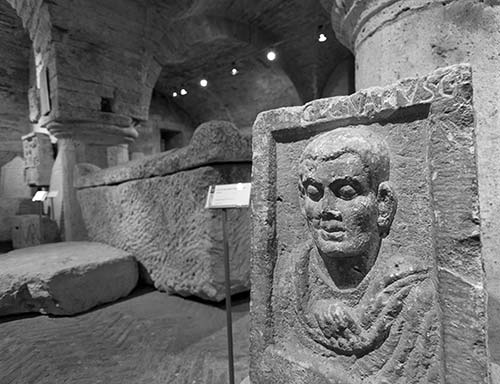
This small, unexciting museum attractively displays its 13th- to 17th-century art (mainly frescoes). There’s a damaged Giotto Madonna and a rare secular fresco (to the right of the Giotto art), but it’s mainly a peaceful walk through a pastel world—best for art lovers.
Cost and Hours: €3, €9 combo-ticket includes Forum and Rocca Maggiore, April-Oct daily 10:00-18:00, closed Nov-March except by appointment, on the main drag between Piazza del Comune and Basilica of St. Francis at Via San Francesco 12—look for banner above entryway, tel. 075-867-4341.
The “big castle” offers a few restored medieval rooms, a good look at a 14th-century fortification, and a fine view of Assisi and the Umbrian countryside. If you’re pinching your euros, skip it—the view is just as good from outside the castle.
Cost and Hours: €6, €9 combo-ticket includes Forum and Pinacoteca, daily June-Aug 9:00-20:00, Sept from 10:00, April-May and Oct 10:00-18:30, shorter hours off-season, last entry 45 minutes before closing, Via della Rocca, tel. 075-815-5077.
This huge basilica, towering above the buildings of Santa Maria degli Angeli—the modern part of Assisi in the flat valley below the hill town—marks the spot where Francis lived, worked, and died. It’s a grandiose church built around a humble chapel—reflecting the monumental impact of this simple saint on his town and the world.
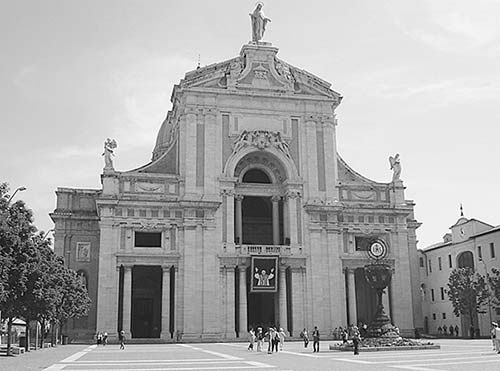
Cost and Hours: Free, Mon-Sat 6:15-12:40 & 14:30-19:30, Sun from 6:45, tel. 075-805-11.
Dress Code: Modest dress is required (no shorts or tank tops).
Visitor Services: A little TI is across the street from the souvenir stands, under the arches (generally Tue-Sun 10:00-12:30 & 15:30-18:00, closed Mon, tel. 075-804-4554). As you face the church, there are big pay WCs behind the bushes on your right.
Getting There: Whether you’re traveling by car or by train, it’s most practical to visit this sight on the way into or out of town. From Assisi’s train station, it’s a five-minute walk (exit station left, after 50 yards take the underground pedestrian walkway—sottopassaggio—on your left, then walk straight ahead, passing several handy eateries). There’s ample well-marked parking next to the train station, and some free (time-limited) spaces tucked behind the basilica.
From the old town, you can reach the basilica on the same Busitalia (line #C) that runs down to the train station (stay on one more stop to reach the basilica; confirm with driver). In the opposite direction, buses from the basilica up to the old town run twice hourly. Leaving the church, the stop is on your right, by the side of the building. For more bus details, see “Getting Around Assisi,” earlier.
Visiting the Basilica: This grand church was built in the 16th century around the tiny but historic Porziuncola Chapel (now directly under the dome) after the chapel became too small to accommodate the many pilgrims wanting to pay homage to St. Francis. Some local monks had given Francis this porziuncola, or “small portion,” after his conversion—a little land with a fixer-upper chapel. Francis lived here after he founded the Franciscan order, and this was where he consecrated St. Clare as a Bride of Christ. What would humble Francis think of the huge church—Christianity’s 10th largest—built over his tiny chapel?
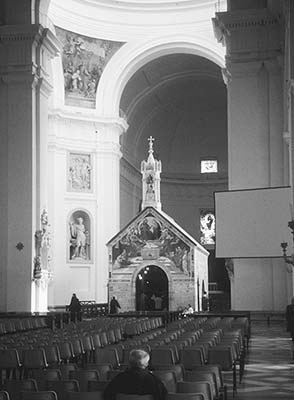
Behind the Porziuncola Chapel on the right, find the Cappella del Transito, which marks the site of Francis’ death on October 3, 1226. Only 44 years old, Francis died as he’d lived—simply, in a small hut located here. On his last night on earth, he invited some friars to join him in a Last Supper-style breaking of bread. Then he undressed, lay down on the bare ground, and began to recite Psalm 141: “Lord, I cry unto thee.” He spoke the last line, “Let the wicked fall into their own traps, while I escape”...and he passed on.
From the right transept, follow Roseto signs to the rose garden. You’ll walk down a passage with gardens on either side (viewable through the windows)—on the left, a tranquil park with a statue of Francis petting a sheep, and on the right, the rose garden. Francis, fighting a temptation that he never named, once threw himself onto the roses. As the story goes, the thorns immediately dropped off. Thornless roses have grown here ever since.
Exiting the passage, turn right to find the Rose Chapel (Cappella delle Rose), built over the place where Francis lived.
The next hallway has exhibits that change occasionally, but you’ll likely see a giant Nativity scene—a reminder to pilgrims that Francis first established the tradition of manger scenes as a teaching aid. The bookshop has some works in English and an “old pharmacy” selling herbal cures.
Porziuncola Museum: Continuing on, you’ll pass this small museum featuring early depictions of St. Francis by 13th-century artists, a model of Assisi during Francis’ lifetime, and religious art and objects from the basilica. On the museum’s upper floor are some monks’ cells, which provide intriguing insight into the spartan lifestyles of the pious and tonsured (€3, ask for English brochure, Thu-Tue 9:00-13:00 & 14:30-17:00, closed Wed, tel. 075-805-1419, www.porziuncola.org).
Located on the slope steeply below the Basilica of St. Clare, this modest church and convent was where Francis received his call and where Clare spent her days as mother superior of the Poor Clares. As you enter, signs point you through a series of simple rooms—including the dining hall where Clare ate with her flock and the room where she died—to a peaceful, flowery courtyard. Drivers can zip right there (watch for the turnoff on the road up to Piazza Matteotti), while walkers descend pleasantly from Assisi for 15 minutes through an olive grove.
In 1206, Francis was inside when he heard the wooden crucifix order him to rebuild the church. (The crucifix in San Damiano is a copy; the original is now displayed in the Basilica of St. Clare.) Francis initially interpreted these miraculous words as a call to rebuild crumbling San Damiano. He sold his father’s cloth for money to fix the church. (The church we see today, however, was rebuilt later by others.) Eventually, Francis realized his charge was to revitalize the Christian Church at large.
As he approached the end of his life, Francis came to San Damiano to visit his old friend Clare. She set him up in a simple reed hut in the olive grove, where he was inspired to write his poem The Canticle of the Sun (see here).
Cost and Hours: Free, daily, convent open 10:00-12:00 & 14:00-18:00, until 16:30 in winter, church opens at 6:15; start walking from the Porta Nuova parking lot at the south end of Assisi and follow the signs; tel. 075-812-273, www.assisiofm.it.
For a picnic with the same birdsong and views that inspired St. Francis, leave the tourists behind and hike to the Rocca Minore (small private castle, not tourable) above Piazza Matteotti.
For a more organized nature experience, try the 160-acre San Francesco Woods (Bosco di San Francesco), where you can follow three routes through forest, monastery ruins, and a land-art installation (€5 suggested donation, picnic area; daily 10:00-19:00, Oct-March until 16:00 and closed Mon Sept-June, last entry one hour before closing, off the piazza in front of the upper basilica, tel. 075-813-157).
If you want to follow further in St. Francis’ footsteps, take a trip up the rugged slopes of nearby Mount Subasio to the humble, peaceful hermitage where Francis and his followers retreated for solitude. Today the spot is marked by a 14th-century friary that’s still occupied by Franciscan monks. You’ll twist through the head-thumping doorframes and steep stairways of the medieval structure, the highlight of which is the tiny, dank cave where Francis would retire for private prayer. Emerging at the far side, near a stone bridge, you’ll see a tree (held together with braces) dating from Francis’ time. This is said to be where Francis preached to the birds. From here, rustic paths lead to open-air “chapels” in the surrounding forest. Be a Franciscan for a little while. Sit peacefully and listen. Pick out the different sounds of nature: wind blowing through the trees, chirping birds, gravel crunching underfoot. And listen for the spaces between the sounds. That’s where Francis found God.
Cost and Hours: Free, daily 8:30-19:00, until 18:00 in winter, tel. 075-812-301.
Getting There: Drive, take a taxi, or hike—there is no public transportation. Drivers can follow signs out of Assisi toward Mount Subasio, then park on the switchback just above the entrance. For hikers starting from Assisi’s Porta Cappuccino gate, it’s a stiff 3-mile, 1.5-hour hike with an elevation gain of about 1,000 feet. You’ll walk along a narrow, paved road (with no shoulders) enjoying brisk air and sporadic views. A souvenir kiosk at the entrance sells drinks and sandwiches, and there are WCs just uphill from the friary.

Assisi accommodates large numbers of pilgrims on religious holidays (see list on here). Finding a room at any other time should be easy. My price rankings are based on rates in spring (April-mid-June) and fall (mid-Aug-Oct). Few hotels are air-conditioned.
$$ Hotel Umbra, a peaceful villa in the middle of town, has 24 spacious, antique-furnished rooms with great view terraces. It’s a bit old-fashioned, but well-run, well-maintained, friendly, and beautifully located. Stepping into the breakfast room is like entering a time warp (RS%, family rooms, air-con, elevator, garden, and view sun terrace, most rooms have views, closed Dec-March, just off Piazza del Comune under the arch at Via degli Archi 6, tel. 075-812-240, www.hotelumbra.it, info@hotelumbra.it, Laudenzi family).
$$ Hotel Ideale, on a ridge overlooking the valley, offers 13 bright and airy rooms (all with views and balconies), a tranquil garden setting, and free (but tight) private parking. As it’s just off the main road into town, it’s a handy pick for timid drivers—but it means a longer walk to the sights (RS%, two apartments with kitchens available, air-con, Piazza Matteotti 1, tel. 075-813-570, www.hotelideale.it, info@hotelideale.it, sisters Lara and Ilaria).
$ Hotel Belvedere, along the road into town from Porta Nuova, has 12 dated rooms—eight with sweeping views (breakfast extra, elevator, large communal view terrace, 2 blocks past Basilica of St. Clare at Via Borgo Aretino 13, tel. 075-812-460, www.assisihotelbelvedere.com, hotelbelvedereassisi@yahoo.it, thoughtful Enrico speaks fluent New Jerseyan).
$ Hotel Pallotta offers seven tight rooms and a beautiful top-floor lounge with rooftop views. The conscientious hosts provide guests with loads of extra niceties including a loaner Assisi guidebook, 24-hour laundry service, and free hot drinks and cake at teatime (RS%, a steep block up from Piazza del Comune at Via San Rufino 6, mobile 338-740-7574, www.pallottaassisi.it, pallotta@pallottaassisi.it; Stefano and Jenni).
$ Hotels on Via Porta Perlici: This steep and characteristic lane, stretching uphill from the Church of San Rufino, is home to three interchangeable hotels with the same owners (Carlo and Christian). Inexpensive and straightforward, these are nicely located at the top of town (all have air-con, elevators, and pay parking nearby). In order from the bottom to the top, there’s Hotel San Rufino (11 rooms, breakfast extra, at #7a; tel. 075-812-803, www.hotelsanrufino.it, info@hotelsanrufino.it); Hotel il Duomo (14 modern rooms with somewhat less character, a bit pricier but breakfast is included, at #13, tel. 075-812-742, www.hotelilduomo.it); and Hotel la Rocca (at the peaceful top end of town, 32 rooms in a medieval shell, breakfast extra, sunny rooftop terrace, decent restaurant upstairs, at #27, tel. 075-812-284, www.hotelarocca.it, info@hotelarocca.it).
$ Camere Carli has six spacious rooms with bizarre floor plans in a solid, minimalist place above an art gallery. The loft rooms are a great value for families (RS%, no breakfast, family rooms, lots of stairs and no elevator, free parking 150 yards away, just off Piazza San Rufino at Via Porta Perlici 1, tel. 075-812-490, mobile 339-531-1366, www.camerecarli.it [URL inactive], carliarte@live.it, pleasant Franco runs the pottery shop below and speaks limited English).
¢ Camere Annalisa Martini is a cheery home amid vines and roses in the town’s medieval core. This is a good budget choice—Annalisa enthusiastically accommodates her guests with a picnic garden, communal refrigerator, and six homey rooms with cheerful peeling wallpaper and flea market furniture (cash only, 3 rooms share 2 bathrooms, laundry service, no breakfast; one block from Piazza del Comune—go downhill toward the Basilica of St. Francis, turn left on Via San Gregorio to #6; tel. 075-813-536, cameremartini@libero.it). Mamma Rosignoli doesn’t speak English, but Annalisa does.
Assisi is filled with convents, most of which rent rooms to pilgrims and travelers. While you don’t need to be a pilgrim or even a Christian to be welcome, it’s just common sense to stay in a convent only if you’re approaching Assisi with a contemplative mindset. Convents feel institutional, house many groups, and are not particularly cheap—but they come with all the facilities you might need to enjoy a spirit-filled visit to Assisi.
$ St. Anthony’s Guest House is where the Franciscan Sisters of the Atonement offer a very warm and tranquil welcome. Their oasis of peace is just above the Basilica of St. Clare. They have 35 beds in 19 sparkling-clean rooms, some with great views—request when you reserve (family rooms available, 2-night minimum, no problem if couples want to share a bed, elevator, no air-con but fans, 23:00 curfew, closed mid-Nov-Feb, library, views, picnic garden, parking by donation; from the parking cashier in Piazza Matteotti, take the stairs down to the “tunnel romano,” walk around the little park, then continue down on the elevator—it’s just to the left at Via Galeazzo Alessi 10; tel. 075-812-542, atoneassisi@tiscali.it).
$$ Le Mandrie di San Paolo (“The Herd of St. Paul”) is a meticulously restored 1,000-year-old stone house renting 13 rustic but comfortable rooms on a hillside high above the valley. Soulful Alex, his brother Andrew, and their team are justifiably proud of their passion for hospitality and connection to the land. They have an olive grove, lots of animals, a beautiful swimming pool, a sauna, a fine restaurant, and spectacular views over Assisi and the valleys of Umbria (apartments and family rooms, mobile 349-821-7867, tel. 075-806-4070, www.agriturismomandriesanpaolo.it, mandrie10@gmail.com). It’s about a 10-minute drive from Assisi, above the village of Viole (a.k.a. San Vitale). Just head southeast of Assisi following signs for Viole; when you enter town, turn left before you reach the arch and follow signs up the hill. Their recommended $$$$ restaurant is a great choice: They produce their own olive oil, cheese, salami, and flour, and fire their ovens with their own wood.
I’ve listed decent, central, good-value restaurants. Assisi’s food is heavy and rustic. Locals brag about their sausage and love to grate truffles on pasta.
To bump up any meal, consider a glass or bottle of the favorite homegrown red wine, Sagrantino de Montefalco. Sagrantino is Umbria’s answer to Brunello (although many wine lovers around here would say that it’s vice versa). Before or after dinner, enjoy a drink on the main square facing the Roman temple...or hang out with the local teens with a takeaway beer under the temple’s columns.
$$$ Trattoria Pallotta is a local favorite with white tablecloths and a living-room ambience. It’s run by a friendly and hardworking family—with Margarita in charge of the kitchen—and offers delicious, well-presented regional specialties, such as piccione (squab, a.k.a. pigeon) and coniglio (rabbit). And they enjoy serving split courses (bis) featuring the two local pastas. They have various fixed-price choices, including an €18 tourist meal, a blowout €35 tasting menu showcasing local specialties, and a vegetarian option. Reservations are smart (Wed-Mon 12:00-14:30 & 19:00-21:30, closed Tue, a few steps off Piazza del Comune across from temple/church at Vicolo della Volta Pinta 2, tel. 075-815-5273, www.pallottaassisi.it).
$$$ Osteria Piazzetta dell’Erba is an inviting, trendy, youthful-feeling restaurant under medieval vaulted ceilings. Dishes are beautifully presented and inspired by local cuisine (Tue-Sun 12:30-14:30 & 19:30-22:30, closed Mon, seating indoors and on a peaceful square, reservations smart, just off the main piazza toward the Cathedral of San Rufino at Via S. Gabriele dell’Addolorata 15a, tel. 075-815-352, www.osterialapiazzetta.it [URL inactive], chef Matteo).
$$ Trattoria da Erminio has peaceful tables on a tiny square and indoor seating under a big, medieval (but air-conditioned) brick vault. Run by Federico and his family for three generations, it specializes in local meat cooked on an open-fire grill. They have good Umbrian wines—before you order, ask for a taste of their specialties (Fri-Wed 12:00-14:30 & 19:00-21:00, closed Thu; from Piazza San Rufino, go a block up Via Porta Perlici and turn right to Via Montecavallo 19a; tel. 075-812-506).
$$ Trattoria degli Umbri has a few nice tables just above the fountain overlooking Assisi’s main square (the main reason to come here). They serve delightful Umbrian dishes and quality wines by the glass (Fri-Wed 12:00-15:00 & 19:00-22:00, closed Thu, Piazza del Comune 40, tel. 075-812-455).
$$ Hostaria Terra Chiama is a bright, modern little place run by Diego and his family, who serve traditional Umbrian dishes with seasonal specials (daily, lunch from 12:30, dinner from 19:00, Via San Rufino 16, tel. 075-819-9051).
$ Pizzeria il Menestrello serves huge, inexpensive Umbrian-style pizzas (wood-fired, thin, and crisp) in an elegant medieval vaulted setting that makes your beer and pizza feel like something King Arthur would eat for dinner (daily 12:00-14:30 & 19:00-22:30, Via San Gregorio 1a, tel. 075-812-746).
There are a few little grocery stores (alimentari) near Piazza del Comune (one is a block uphill from the main square, at Via San Rufino 19), plus bakeries selling pizza by the slice.
La Bottega dei Sapori is handy for assembling a picnic of Umbrian treats: good porchetta sandwiches and specialty items, including truffle paste and olive oil. Sandwich chef Saverio also makes a nice taglieri misti (meat and cheese plate) starting at €18 for two people. They like expensive ingredients, so it can get pricey here—be sure you’re clear on the cost when you order (daily 9:30-21:00, shorter hours off-season, Piazza del Comune 34, tel. 075-812-294, Fabrizio). You can eat your sandwich on any of the benches surrounding the piazza.
Pizza al Taglio da Andrea, facing the Church of San Rufino on Piazza San Rufino, has perhaps the best pizza-by-the-slice in town. Locals also like their torta al testo, the Umbrian flatbread sandwich (daily 8:00-21:30, Via San Rufino 26, tel. 075-815-325).
For locations, see the “Assisi” map near the beginning of this chapter.
$$ Locanda del Podestà, tucked inside a medieval gate just above the basilica, is a cozy spot with a traditional menu of tasty grilled Umbrian sausages, gnocchi della locanda (with gorgonzola and truffles), and tasty scottadito (“scorch your fingers”) lamb chops (Thu-Tue 12:00-14:30 & 19:00-21:30, closed Wed and Feb, 5-minute walk uphill along Via Cardinale Merry del Val from basilica, Via San Giacomo 6C—see map on here, tel. 075-816-553).
$$$ Le Terrazze di Properzio, just up the street from Podestà, is the place to go to dine with a big view on a lovely terrace. The traditional menu includes seasonal specials. While the interior has a nice atmosphere, I’d skip this restaurant unless you’re seated outside—you’re paying a premium for the terrace (daily 12:00-14:30 & 19:00-21:30, terrace closed in bad weather, Via Metastasio 9, tel. 075-816-868).
$$$$ Le Mandrie di San Paolo, in a 1,000-year-old farmhouse a 10-minute drive outside Assisi, makes many of its own ingredients and serves an exquisite dinner to guests and nonguests alike. This is a good example of a “zero-kilometer meal”—all the ingredients are sourced on the property (€30-35 four-course meal, daily 19:45-22:00, in winter on request, reservations preferred, see “Sleeping in Assisi” for location, www.agriturismomandriesanpaolo.it).
If the train station’s ticket office is closed, you’ll find a ticket machine on the platform. Up in Assisi’s old town, you can get train information and tickets from Agenzia Viaggi Stoppini (see listing under “Helpful Hints,” earlier). That’s also the best place to buy bus tickets—except for the FlixBus connection to Siena, which can easily be booked online.
From Assisi by Train to: Rome (6/day direct, 2 hours, more options with a change in Foligno), Florence (7/day direct, 2-3 hours), Orvieto (roughly hourly, 2-3 hours, with transfer in Terontola or Orte), Siena (10/day, about 4 hours, most involve 2 changes; bus is faster). Italian train timetables change frequently—double-check details at www.trenitalia.com.
By Bus: Service to Rome is operated by the Sulga bus company (2/day, 3 hours, pay driver, departs from Piazza San Pietro below the Basilica of St. Francis, arrives at Rome’s Tiburtina station, one departure continues on weekdays to Fiumicino airport, tel. 800-099-661, www.sulga.it). FlixBus runs buses to Siena (2 hours, better than the long train ride, https://global.flixbus.com). Be clear on the departure point for your bus: Sometimes it leaves from Santa Maria degli Angeli, in the valley below Assisi (you’ll find the stop at the far end of the big, long park in front of the Basilica of Santa Maria degli Angeli); other departures are from Piazza Unità d’Italia, below the Basilica of St. Francis. Don’t take the bus to Florence; the train is better.
By Plane: Perugia/Assisi Airport is about 10 miles from Assisi (code: PEG, tel. 075-592-141, www.airport.umbria.it). Bus service between Assisi and the airport is so sporadic (just a few times a day—see www.umbriamobilita.it) that most travelers wind up taking a taxi (about €30).